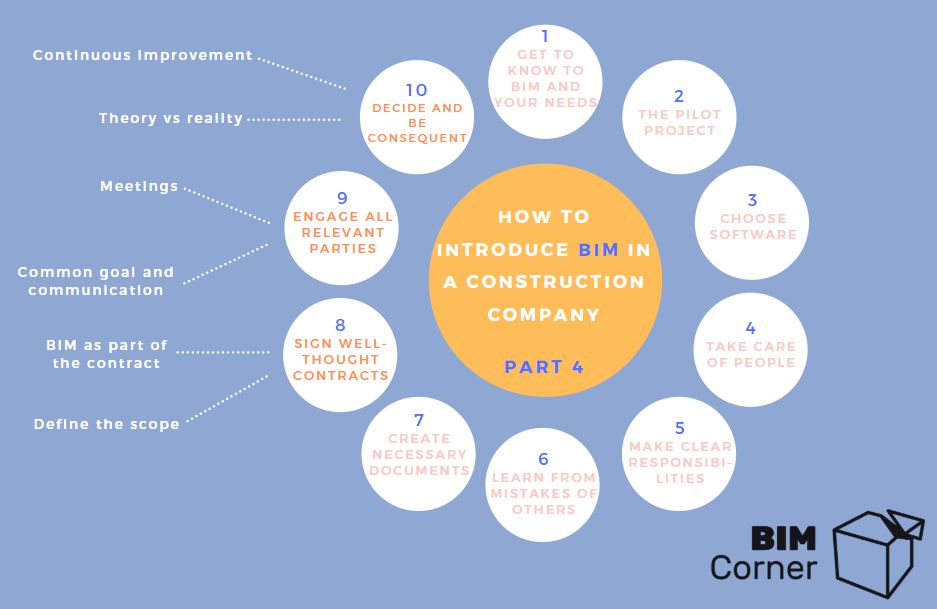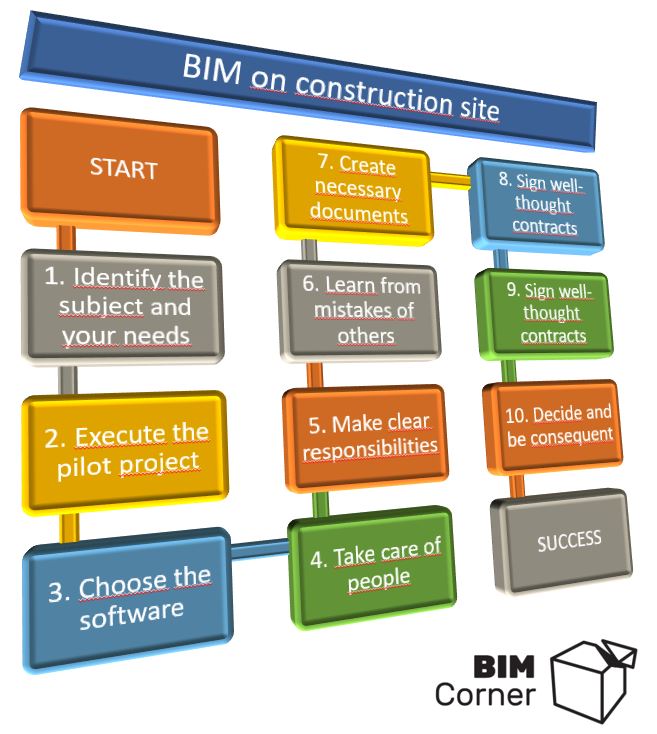Have you ever experienced that in your head you had “all this BIM” quite well arranged, but when it came to reality of the project, its other participants did something completely different than you had expected? Everything was so obvious and seemed understandable, right? However, in practice, each of us, working in our specialization and having different experiences, perceives BIM-reality differently. That is why it is so important to sign well-considered contracts, involve all people working on the project and being consistent in our (often new) activities with BIM. With this introduction we would like to invite you to read the fourth part of the series ‘BIM at the construction site’!
A small reminder: in our previous articles we wrote about getting to know to the topic and our own needs (part 1), issues regarding choice of software and how to take care of the people (part 2) and responsibilities, learning from other’s mistakes and need for documentation (part 3).
BIM on construction site - the whole serie in 10 points:
- Identify the subject and your needs. (part 1)
- Execute the pilot project. (part 1)
- Choose the software. (part 2)
- Take care of people. (part 2)
- Make clear responsibilities. (part 3)
- Learn from the mistakes of others. (part 3)
- Create necessary documents. (part 3)
- Sign well-thought contracts. (this article)
- Engage all relevant parties. (this article)
- Decide and be consequent. (this article)
BIM IN CONSTRUCTION COMPANY AND ON SITE - PART 4.
List Of Contents
8. Sign well-thought contracts
Remember that BIM is a challenge not only for execution companies – it is often totally new for designers, subcontractors, suppliers and clients. That is why it is even more important to precisely formulate expectations and share of responsibility. For simplicity, we are assuming here that the contract between the main contractor and the investor is already signed. Therefore we will discuss issues related to contracts between the execution company and suppliers, designers and subcontractors.
A. Specify the scope.
The basis of each contract is a clear definition of three basic topics:
1) Scope of work or delivery and its quality.
2) Time – with time schedule of works or deliveries.
3) Budget.
Theoretically, these are obvious points in each contract. However, I have experienced myself working on a project where none of them was included in practice in a contract with the design office for many millions of Norwegian kroner. It is easy to downplay contract meetings, especially when you trust that the supplier / designer / subcontractor ‘knows what he should do’, ‘doesn’t do it for the first time’, or ‘the schedule is attached’. Especially when the negotiations take place immediately after the information that we have won the contract and there is a great atmosphere of initial victory.
Added to this is the BIM technology and relatively little experience working with it by many participants in the construction process. Therefore in addition to the above-mentioned three points, let’s focus on including specific records for BIM in the contract.
B. Include BIM as part of the contract.
The most important issues that we need to remember about (you can read more about the topic in an article from a company Clarkslegal LLP) are:
1) Include requirements for BIM and documentation.
These requirements should be included in the previously prepared BIM Execution Plan (BEP) or BIM Manual. We wrote about both of these documents in point number 7 in the third part of the series ‘BIM on site and in the contractor’.
The requirements, together with the project description, should be clearly communicated to the other parties. Take for example the contract we want to sign with a company supplying formwork system as a contractor. Let’s assume that we use only 3D models on the project and do not produce any drawings. In this case, it should be emphasized that all documentation needed by the supplier to prepare a detailed offer will be made available on the server in the form of .ifc files and the supplier is responsible for its use and possible adaptation to its production. A similar provision should appear in the contract with the subcontractor – he must take responsibility for the use of the model and ensure that his employees are qualified to use it during construction.
2) Determine responsibility and risk allocation.
Due to the fact that many people can access the model at the same time and different companies can work with it, clear rules regarding responsibility on the project should be set. This applies especially to working with designers. It may be that we have either one design office that works on the whole project, or there are several different design offices that prepare their own models, e.g. for installations.
Let’s agree on who is responsible for particular discipline models and who for the main model, that connects all the others. Who will update them and how often, who will carry out the collision control? It can be either a main contractor or a design company with the right tools and experience. In this case, BIM manager from the contractor or from the designer may have the main responsibility.
In this case, it is worth including a provision about which part of the model and at what time the relevant persons or companies will have access to.
3) Insurance.
By ‘insurance’ I mean not only how much the organization is insured for in an event of a mistake, but also the assurance that the work will be carried out in accordance with the assumptions of BIM technology. Therefore, let us include requirements in terms of staff, equipment and technology. These can be, for example:
- Presence of BIM manager from subcontractor / designer XX days a week at the construction site.
- Participation in weekly coordination meetings on a multi-disciplinary 3D model.
- Providing as-built documentation in .ifc files at the latest two weeks after the execution of the works.
- Having a BIM-kiosk at the construction site and providing the necessary software to the foremen / work managers.
The key in this point is to include the contractual penalties, i.e. the amount that the company must pay if it does not meet its conditions within the required time. Without financial consequences, it will be very difficult for us to force other organizations to adapt to the new approach to work, especially since it often involves large investments.
4) Intellectual property and ownership.
In many countries, intellectual property is not yet a ‘tested’ issue. On one project, working on the same model, we can have many designers from different, normally competing companies. In the ‘old world’ of drawings, paper documentation (or .pdf) was obtained and made available to selected companies or individuals. And so, for example, installation designers were given an outline of the building, installers a plan of arrangement and connection of devices, some description and usually… nothing more. When we use BIM technology at the ‘Level III’, where ‘all’ information is contained in one model, it suddenly turns out that every entity performing even relatively small works at the construction site has access to information about the entire project. This also applies to detailed technical solutions, including supplier information, reinforcement details, in some cases the price, warranty time, etc.
Unfortunately, even in international literature, issues of intellectual property and copyright are not entirely clear. However, it is worth being aware of this issue when sharing the model(s) or information with other organizations – it can often be something that we do not necessarily want to share with others. Therefore, we recommend specifying the conditions and restrictions on the use of 3D models at various stages of the project, and provide only the necessary information to the right people or companies.
To sum up, especially in countries where there is not much practical experience of working with BIM technology yet and there are no standard contract points describing it, each contract should be considered individually. It should also reflect the practical scope of BIM use on a given project and the related challenges.
9. Engage all relevant parties.
A. The common goal and communication.
It can be said that each project is unique. Different people and companies work on each project, which means that we almost always have to start cooperation from the beginning.
We can divide project stakeholders (or simply persons or organizations having a direct or indirect impact on the project) into internal (those who are inside our organization), external (those outside it) and the client. For example, in an execution company we need to include: contract manager, construction manager, workers, surveyors, site engineers, health and safety engineer, as well as people who are not always working directly on the project, such as teams responsible for tender, work preparation, marketing and HR. In turn, external stakeholders are e.g. designers, subcontractors, suppliers, environmental organizations or local authorities.
As we can see, there can be a lot of parties ‘interested’ in the project. From the perspective of working with BIM technology, it is important to involve the right people from the selected organization as soon as possible. First of all, we should clearly define and convey the goal that we want to achieve through the use of BIM and what will be associated with it. We will act in a slightly different way with each stakeholder. Suppose we have won a design and build contract as the main contractor. In this case, we engage designers at an early stage and jointly determine the scope of use of BIM. Then we contact the client to organize a meeting regarding BIM and inform him what our cooperation will look like and how he will be involved in the work. At the same time, we are conducting negotiations with suppliers and subcontractors to inform them what conditions regarding BIM they have to mmet in order to sign a contract with us and work on the project.
Awareness about the common goal and motivation of others to pursue it are extremely important and can often decide about the success or failure of the entire project. That is why it is so important to provide the right information to the right person at the right time.
B. Meetings.
Despite the fact that sometimes we all complain about too many meetings, there are those that are hard to do without. Let’s start with the ‘project kick-off meeting’. Its main goal is to ensure that all project participants have basic knowledge about it, which translates into a shared understanding of tasks, purpose and responsibility. You can not underestimate the very fact of getting to know each other ‘in reality’, since you will work with those people quite a lot in the future. We suggest conducting the following kick-off meetings:
- Inside our organization – inviting all project participants in our company, as well as people who had worked on it during the tender. This will ensure the transfer of knowledge and assumptions made in the earlier phases.
- With the designer – among the participants there should be designers of all disciplines, as well as the key people working on the project in our company. Especially those who may have a direct contact with the designers, such as the design, construction and site managers.
- BIM-meeting with the client – even if there is no such requirement, it is worth inviting the investor to a meeting with the designers and key people from the construction. This meeting should establish an understanding for use of the BIM methodology on the project and all the related procedures, challenges and possibilities.
- With suppliers and subcontractors – these are smaller meetings conducted separately with each relevant company, allowing to transfer knowledge about the project, the biggest challenges, as well as discuss the principles of cooperation.
In addition, we need to schedule coordination meetings between various disciplines, and separate design meetings at an early stage of the project.
10. Decide and be consequent.
A. Clash with the reality.
Let’s assume that we followed all the points described earlier when introducing BIM technology to our organization. Often in this situation, unfortunately, there is… a clash with the reality. It turns out that the software we use has considerable limitations, subcontractors and suppliers still want drawings, and the designer does not produce 3D documentation faster than traditional drawings. To top that, we still hear that ‘it is impossible to build without drawings’. Skeptics are just waiting for some collision or mistake, just to point out that all this BIM does not solve problems and there is no need to invest in something that does not work. Unfortunately, these are the realities. It is true that people are “resistant to change”. There is an interesting passage in a book ‘Switch: How to Change Things When Change Is Hard‘:
‘Two professors at Harvard Business School, writing about organizational change, say that change is hard because people are reluctant to alter habits that have been successful in the past. ”In the absence of a dire threat, employees will keep doing what they’ve always done.” As a result, the professors emphasize the importance of crisis: ”Turnaround leaders must convince people that the organization is truly on its deathbed – or, at the very least, that radical changes are required if the organization is to survive and thrive.”
I believe that each of us can confirm the truth of these words from our own experience. Therefore, it is worth to be patient and prepare strong arguments to convince even the most resistant individuals. It should be emphasized all the time that BIM is not some future idea, but actually the ‘now’ – and either our organization will adapt to this new reality or it will not be competitive and we would need to close it. At the same time, be open to changes from the original assumptions and adapt your expectations to reality.
B. Continuous improvement.
- The subcontractor / supplier requests drawings in .pdf or .dwg format so that he can prepare his offer. He claims that he does not have software to open the .ifc files. It is clear that this can be done in many free 3D browsers or applications, however, he does not want to take responsibility for downloading all the data needed. Simply because he has no experience and is afraid that he may miss something. Solution? Be consistent and provide only 3D models + any required description or sketches. If not this supplier, there will be another. If we really want to sign a contract with a specific company with which we have good relations, we can offer several hours of training for its staff and show how to work with BIM.
- The subcontractor agrees on ‘everything’ just to win the contract, and after signing it, it turns out that he has neither experience nor tools to perform work in BIM technology. We have no choice but to ask him to meet the contractual requirements, and if that doesn’t work, impose contractual penalties on him. Ultimately, if nothing else helps, we are forced to terminate the contract and look for another company. Of course, all this looks easy in theory, but in practice everyone is aware of the big consequences this situation can have on the project.
Summary of the fourth part of BIM in construction company and on site.
In the fourth part of the series ‘BIM on construction site and in the execution company’, we looked at issues related to contracts in relation to BIM technology and the need to involve all project participants in the process. We also described the typical challenges of everyday life – when theory meets practice.
We need to remember that BIM is just a tool and that we need to adapt to our own needs. Therefore, while introducing a new technology to our organization, let’s start by finding the answers to the following questions: what do we need BIM for and what do we want to achieve using it? What is our priority? How can we, using this technology, develop ourselves and our company to ultimately save time, money and be more competitive on the market?
Do you use BIM on your construction site or on your project? Do you have a clear understanding about responsibilities and who does what? What documents have you developed and used in practice so far?
Share your experiences below with us in the comments! Or write us at [email protected]!
Check out other articles about BIM in construction company and on site:











